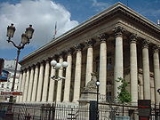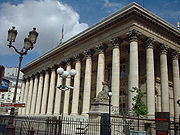
Paris Bourse
Encyclopedia


Paris
Paris is the capital and largest city in France, situated on the river Seine, in northern France, at the heart of the Île-de-France region...
stock exchange
Stock exchange
A stock exchange is an entity that provides services for stock brokers and traders to trade stocks, bonds, and other securities. Stock exchanges also provide facilities for issue and redemption of securities and other financial instruments, and capital events including the payment of income and...
, known as Euronext Paris
Euronext Paris
Euronext Paris is France's securities market, formerly known as the Paris Bourse, which merged with the Amsterdam, Lisbon and Brussels exchanges in September 2000 to form Euronext NV, which is the second largest exchange in Europe behind the UK's London Stock Exchange...
from 2000 onwards.
History and functioning
Historically, stock trading took place at several spots in Paris, including rue Quincampoix, rue Vivienne (near the Palais RoyalPalais Royal
The Palais-Royal, originally called the Palais-Cardinal, is a palace and an associated garden located in the 1st arrondissement of Paris...
), and the back of the Opéra Garnier (the Paris opera house). In the early 19th century, the Paris Bourse's activities found a stable location at the Palais Brongniart, or Palais de la Bourse, designed by architect Alexandre-Théodore Brongniart
Alexandre-Théodore Brongniart
Alexandre-Théodore Brongniart was a prominent French architect.Born in Paris, France. A prominent member of Parisian society, in 1767 he married Anne-Louise d'Egremont...
.
From the second half of the 19th century, official stock markets in Paris were operated by the Compagnie des agents de change, directed by the elected members of a stockbroker
Stock broker
A stock broker or stockbroker is a regulated professional broker who buys and sells shares and other securities through market makers or Agency Only Firms on behalf of investors...
s' syndical council. The number of dealers in each of the different trading areas of the Bourse was limited. There were around 60 agents de change (the official stockbrokers). An agent de change had to be a French citizen, be
nominated by a former agent or his estate, and be approved by the Minister of Finance, and he was appointed by decree of the President of the Republic. Officially, the agents de change could not trade for their own account nor even be a counterpart to someone who wanted to buy or sell securities with their aid; they were strictly brokers, that is, intermediaries. In the financial literature, the Paris Bourse is hence referred to as order-driven market, as opposed to quote-driven markets or dealer markets, where price-setting is handled by a dealer or market-maker. In Paris, only agents de change could receive a commission, at a rate fixed by law, for acting as an intermediary. However, parallel arrangements were usual in order to favor some clients' quote. Moreover, until about the middle of the 20th century, a parallel market known as "La Coulisse" was in operation.
Until the late 1980s, the market operated as an open outcry
Open outcry
Open outcry is the name of a method of communication between professionals on a stock exchange or futures exchange. It involves shouting and the use of hand signals to transfer information primarily about buy and sell orders...
exchange, with the agents de change meeting on the exchange floor of the Palais Brongniart. In 1986, the Paris Bourse started to implement an electronic trading system. This was known generically as CATS
CATS (trading system)
CATS is an automated exchange system developed for the Toronto Stock Exchange in 1977. CATS was one of the first technologies allowing for a full automation of the price-setting process in a stock exchange. This technology was implemented in several other stock exchanges in the 1980s...
(Computer Assisted Trading System), but the Paris version was called CAC (Cotation Assistée en Continu
Cotation Assistée en Continu
Cotation Assistée en Continu was an electronic trading system used at the Paris Bourse, the French stock exchange, in the 1980s and 1990s. It was introduced in 1986 for trading less liquid equities, and in 1989 it was operational for all listed stocks. The acronym is also used to refer to the CAC...
). By 1989, quotations were fully automated. The Palais Brongniart hosted the French financial derivatives exchanges MATIF
MATIF
MATIF SA is a private corporation which is both a futures exchange and a clearing house in France. It was absorbed in the merger of the Paris Bourse with Euronext NV to form Euronext Paris...
and MONEP, until they were fully automated in 1998. In the late 1990s, the Paris Bourse launched the Euronext
Euronext
Euronext N.V. is a pan-European stock exchange based in Amsterdam and with subsidiaries in Belgium, France, Netherlands, Portugal and the United Kingdom. In addition to equities and derivatives markets, the Euronext group provides clearing and information services...
initiative, an alliance of several European stock exchanges.
History
- Lehmann, P.-J. 1991 La Bourse de Paris, Paris: Dunod.
- Lehmann, P.-J. 1997 Histoire de la Bourse de Paris, Paris: PUF.
- Muniesa, F. 2005 "Contenir le marché: la transition de la criée à la cotation électronique à la Bourse de Paris", Sociologie du Travail 47(4): 485-501.
- Walker, D. A. 2001 "A factual account of the functioning of the nineteenth-century Paris Bourse", European Journal of the History of Economic Thought 8(2): 186-207.
Structure
- Biais, B., Foucault, T. and Hillion, P. 1997 Microstructure des marchés financiers: institutions, modèles et tests empiriques, Paris: PUF.
- Hamon, J. 1995 Marché d'actions: architecture et microstructure, Paris: Economica.
- Hamon, J. and Jacquillat, B. 1992 Le marché français des actions: études empiriques 1977-1991, Paris: PUF.

